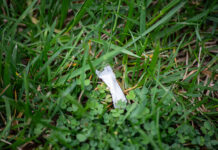Think about how much time we spend indoors every day. Whether we’re cramming in the library, decompressing in the student center, or ignoring our responsibilities with a Netflix binge, most of us are guilty of being cooped up inside for most of the day. Of course we can’t control the unpredictable, inconsistent, and down-right rude weather patterns in western Pennsylvania, but we can make the best of the time we spend inside. Next time you’re rebelling against Mother Nature, consider the quality of the air you’re breathing into your body.
Many of the products in your office or room may be emitting toxins and chemicals into the air right beneath your noses. The concentration of these chemicals, known as volatile organic compounds (VOCs), has been found to be two to five times higher inside a confined space compared to the outdoors. So what are these products? You’re probably thinking of some of the more obvious items, such as paints, harsh cleaners, or aerosol sprays. But don’t be fooled—even the most unsuspecting objects, like carpet, furniture, and cosmetics can be perpetrators of this crime environmental scientists call indoor air pollution. When using these items in a poorly ventilated space, VOCs (i.e. the bad guys) begin to accumulate, which can be detrimental to your health both short and long-term. According to the United States Environmental Protection Agency, you may experience immediate responses such as eye, nose, and throat irritation, headaches, dizziness, or fatigue. Exposure to this type of environment for a prolonged period of time, however, has been linked to the development of respiratory diseases, heart disease, and even cancer. This is alarming, right? Don’t panic! Let me plant a potential solution for you that may do more than just improve the quality of your air.
House plants are known for sprucing up a bland office or creating a calm atmosphere, but their positive contributions to our environment don’t stop there. Plants are natural air purifiers, which, in the simplest terms, means they absorb VOCs through pores on the surface of their leaves and neutralize them. Phytoremediation, the process that results in clean air, is just one of the numerous benefits associated with being a plant parent. Adopting a plant can improve your mood, heighten productivity, and even encourage an active lifestyle. Dr. Rebecca Thomas, an Assistant Professor in SRU’s Parks and Conservation department, is well-versed in research that supports the multifaceted benefits of plants for health and wellness. When asked how someone with a less experienced green thumb should get involved in plant care, Dr. Thomas suggests, “Start with something that’s really easy to grow, like a spider plant. . .[they] can sit there for weeks without water and still continue to thrive.” Spider plants, along with a variety of other common house plants, are as effective at cleaning indoor air as they are low-maintenance. In fact, multiple research studies have concluded that spider plants, English ivy, and snake plants are some of the most powerful air purifiers and are widely considered to be the easiest plants to care for in reference to water, sunlight, and warmth demands.
Although plants have proven to be efficacious in air purification, we are responsible as humans to take additional measures to reduce our contributions to indoor air pollution. We can do this by ensuring adequate ventilation when using chemical products, properly sealing chemical containers, using water-based or solvent-free paints, and disposing of chemicals at the appropriate facilities. Not only should we make strides toward the improvement of our indoor environment, but we should be more cognizant of the way we treat our outdoor environment, too.
As we celebrate Earth Month this April, we need to acknowledge that our momentary decisions can leave lasting effects, and recognize that we can make a choice that is in favor of both our planet and our health.







